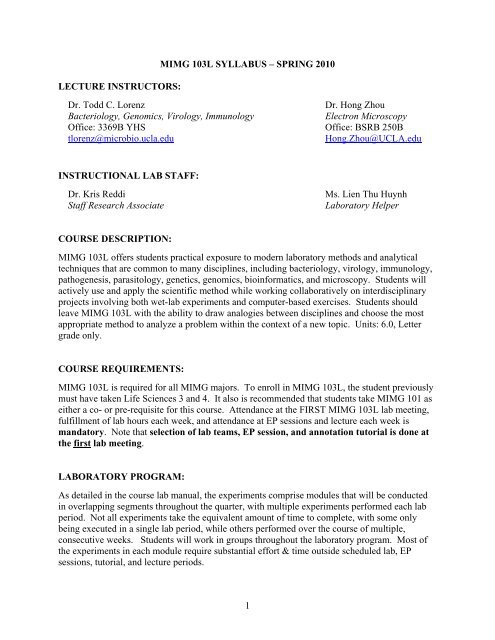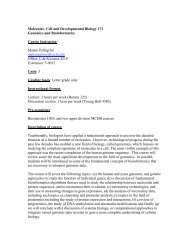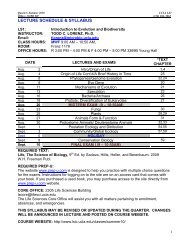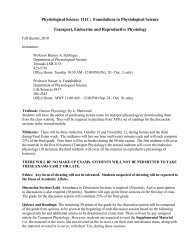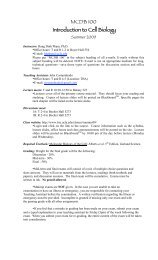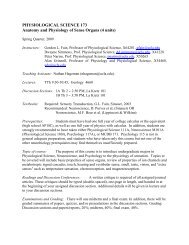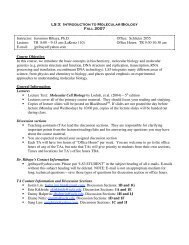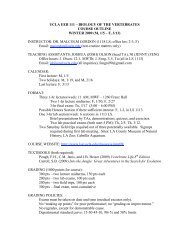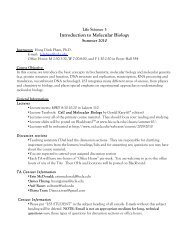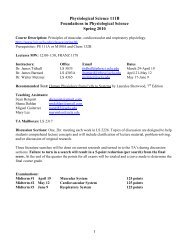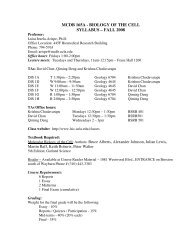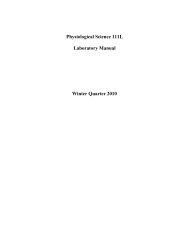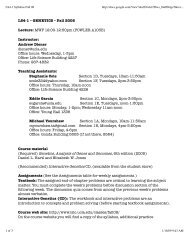1 MIMG 103L SYLLABUS â SPRING 2010 LECTURE ... - UCLA
1 MIMG 103L SYLLABUS â SPRING 2010 LECTURE ... - UCLA
1 MIMG 103L SYLLABUS â SPRING 2010 LECTURE ... - UCLA
You also want an ePaper? Increase the reach of your titles
YUMPU automatically turns print PDFs into web optimized ePapers that Google loves.
<strong>LECTURE</strong> INSTRUCTORS:<strong>MIMG</strong> <strong>103L</strong> <strong>SYLLABUS</strong> – <strong>SPRING</strong> <strong>2010</strong>Dr. Todd C. LorenzBacteriology, Genomics, Virology, ImmunologyOffice: 3369B YHStlorenz@microbio.ucla.eduDr. Hong ZhouElectron MicroscopyOffice: BSRB 250BHong.Zhou@<strong>UCLA</strong>.eduINSTRUCTIONAL LAB STAFF:Dr. Kris ReddiStaff Research AssociateMs. Lien Thu HuynhLaboratory HelperCOURSE DESCRIPTION:<strong>MIMG</strong> <strong>103L</strong> offers students practical exposure to modern laboratory methods and analyticaltechniques that are common to many disciplines, including bacteriology, virology, immunology,pathogenesis, parasitology, genetics, genomics, bioinformatics, and microscopy. Students willactively use and apply the scientific method while working collaboratively on interdisciplinaryprojects involving both wet-lab experiments and computer-based exercises. Students shouldleave <strong>MIMG</strong> <strong>103L</strong> with the ability to draw analogies between disciplines and choose the mostappropriate method to analyze a problem within the context of a new topic. Units: 6.0, Lettergrade only.COURSE REQUIREMENTS:<strong>MIMG</strong> <strong>103L</strong> is required for all <strong>MIMG</strong> majors. To enroll in <strong>MIMG</strong> <strong>103L</strong>, the student previouslymust have taken Life Sciences 3 and 4. It also is recommended that students take <strong>MIMG</strong> 101 aseither a co- or pre-requisite for this course. Attendance at the FIRST <strong>MIMG</strong> <strong>103L</strong> lab meeting,fulfillment of lab hours each week, and attendance at EP sessions and lecture each week ismandatory. Note that selection of lab teams, EP session, and annotation tutorial is done atthe first lab meeting.LABORATORY PROGRAM:As detailed in the course lab manual, the experiments comprise modules that will be conductedin overlapping segments throughout the quarter, with multiple experiments performed each labperiod. Not all experiments take the equivalent amount of time to complete, with some onlybeing executed in a single lab period, while others performed over the course of multiple,consecutive weeks. Students will work in groups throughout the laboratory program. Most ofthe experiments in each module require substantial effort & time outside scheduled lab, EPsessions, tutorial, and lecture periods.1
<strong>LECTURE</strong>:Section Room Day TimeAll sections Haines Hall A25 T 9:00 AM – 10:15 AMLABS:Section Room Days Time TA1A 3370 YH TR 10:30 AM - 1:20 PM Erin McDonald1B 3340 YH TR 2:00 PM - 4:50 PM Rachel Resop1C 3370 YH WF 12:00 PM - 2:50 PM Erin McDonaldEnrollment for each lab section limited to 20 students.ANNOTATION TUTORIAL:All studentsTwo hours once per quarter. Meetings will be offered on once per weekstarting week 2 and continuing through week 9 of the quarter. On the first day oflab, all students will select date and sign up for one of the eight sessions. No morethan 3 students per lab section may attend any single tutorial session, and everytutorial session must have at least 2 students from each lab section in attendance.These tutorial sessions will be held as follows.Day Room Time InstructorT 4335 YHS (SLC) 5:00 PM - 6:50 PM Dr. Todd LorenzEnrollment for each tutorial session limited to 9 students.EXPERIMENT PROGRESS (EP) SESSIONS:All sectionsOne hour per week. Meetings will be offered two days per week at thefollowing times. Since this activity needs to be coordinated with lab teammembers, on the first day of lab students will select time and sign up for anExperiment Progress (EP) session. TR sections need to be available for EP onWednesdays, while WF sections need to be available for EP on Thursdays.Session Room Day Time TA1 3340 YH W 11:00 AM - 11:50 AM Erin McDonald2 3340 YH W 3:30 PM - 4:20 PM Rachel Resop3 3340 YH R 9:30 AM - 10:20 AM Rachel Resop4 3370 YH R 3:30 PM - 4:20 PM Erin McDonaldEnrollment for each EP session limited to 18 students on W and 12 students on R.2
MATERIALS REQUIRED FOR THIS COURSE:1. Lab Manual – Purchased at Course Reader Material, 1081 Westwood Blvd., Los Angeles,CA, (310) 443-3303. Easel binder required for lab!2. Textbook (see details in next section)3. Permanently bound lab notebook4. Sharpie marker5. Ball-point pen6. USB flash drive (for saving and transporting computer-generated data)7. Valid email account and internet access (for access to course website, online instructionalmaterials, and instructor/TA/student correspondence). The email address on file with theregistrar will be used for correspondence. Students are responsible for maintaining theiraccounts and ensuring email correspondence does not go to ‘Junk Mail’ or ‘Spam’ folders.Students should check for email from TAs or instructors on a daily basis.All of these items or resources will be used in the labs starting the first week of instruction(3/29/10) and therefore must be purchased or prepared prior to the first day of class.TEXTBOOK:Microbiology: An Evolving Science by Joan L. Slonczewski and John W. Foster, W.W. Norton& Company, Inc., 2008Students are required to purchase an ebook, rather than a hard copy text. Students may purchasethe ebook directly through the publisher’s website:http://www.wwnorton.com/gateway/entry.asp?site=microbio_ebookA 12-month ebook registration may be purchased for $60.There are copies of the hard bound textbook on reserve in Powell Library. Access to animationsis free and open to students at the publisher’s student website (‘Studyspace’):http://www.wwnorton.com/studyspaceThe hard bound text is $160, which students may purchase directly from the publisher (Norton)through their Student Store:http://www.wwnorton.com/students/titles/biology/mbio/order.php3
GRADES:The final grade for <strong>MIMG</strong> <strong>103L</strong> will be calculated as follows:Points (Percentages)Lecture Participation 50 ( 5%)Fulfillment of Laboratory Hours0 (mandatory)Experiment Progress Sessions Participation 60 ( 6%)Annotation Tutorial Participation 25 ( 3%)Annotation Presentation/Peer Evaluation 40 ( 4%)Homework (3 total, 20 – 30 pts each) 80 ( 8%)Lab Reports (3 total, 40 – 45 pts each) 125 (13%)Quizzes (5 total, 15 pts each, lowest quiz score dropped) 60 ( 6%)Effort & Conduct Evaluation 80 ( 8%)Lab Notebook (including 60 pt imgACT online notebook) 130 (13%)Midterm Exam (Wed., 04/28/10, 5:00 PM – 7:00 PM) 125 (12%)Final Exam (Thurs., 06/07/10, 6:30 PM – 9:30 PM) 225 (22%)TOTAL 1000 (100%)EXPLANATION OF GRADE COMPONENTS:Lecture ParticipationAlthough no one will be taking role at lecture each week, each student is responsible for allmaterial presented and distributed during lecture, as well as any and all courseannouncements provided during lecture. A set of lecture-based, one-minute questions willbe presented in class, with students asked to record their responses on note cards provided bythe instructor. Note cards will be collected and used to monitor participation in lecture.Please note that it is disruptive to instruction when students arrive late or leave early.Consistent interruption of class in this manner will result in the loss of points.Fulfillment of Laboratory HoursAttendance at the FIRST <strong>MIMG</strong> <strong>103L</strong> lab meeting is mandatory. If you do not attend, yourspace will be reassigned and you will have to drop the class through URSA. Any exceptionsto this policy must receive approval by course instructors before any anticipated absence, orthere must be a serious, mitigating circumstance after the fact, also subject to approval. In allcases, you must be able to provide evidence to establish the basis of any request.Attendance at each lab period is also required. It is not feasible to make up laboratory workbecause of the complexity and cost and because many experiments involve work on materialsprepared in previous lab periods. Teaching Assistants must be notified ahead of time foranticipated lab absences or late arrivals to lab. In addition, you must obtain permission fromcourse instructors before any anticipated absence, or there must be a serious, mitigatingcircumstance after the fact, also subject to approval. In all cases, you must be able to provideevidence to establish the basis of any request. If a lab is missed and absence is approved by4
instructors, it will be at the sole discretion of the instructors, in each individual case, as towhether a student will be allowed to prorate points for the missed lab, or merely lose thosepoints. Only two excused lab absences are permitted during the quarter.Experiment Progress (EP) Session ParticipationDuring the first laboratory meeting of the quarter, students will be organized into teamscomprised of 4 to 6 individuals. In coordination with other team members, each student willsign up for one session of Experiment Progress (EP) per week. If the team’s regularlyscheduled laboratory periods fall on Tuesday and Thursday each week, then team membersmust make arrangements to attend EP on Wednesday each week. Alternatively, if the team’sregularly scheduled laboratory periods fall on Wednesday and Friday, then team membersmust make arrangements to attend EP on Thursday each week. At least two or three teammembers must be present at a single EP session, with team member attendance spread overtwo EP sessions per week.All sessions of EP will be held in an instructional laboratory or SLC computer classroom,where students will conduct procedures related to their experiments initiated during in thescheduled laboratory periods. These activities will be supervised by teaching assistants orinstructors, although no formal instruction will be provided during these sessions. Studentswill receive directions during scheduled laboratory meetings, with details outlined in thelaboratory manual, and will be expected to perform these additional tasks between scheduledlaboratory periods. Students must be available for the entire one-hour session, andstudents must sign-in each week to ensure their attendance is recorded. Only one excusedabsence is permitted during the quarter.Annotation Tutorial ParticipationDuring the first laboratory meeting of the quarter, each student will sign up for one tutorialsession. The sessions begin week 2 and continue through week 9 of the quarter. Thus, allstudents must make arrangements to be available for one of the eight sessions held during thequarter. These sessions are held in a computer laboratory classroom in the Science LearningCenter on the 4th floor of Young Hall. No more than 3 students per lab section may attendany single tutorial session, and every tutorial session must have at least 2 students from eachlab section in attendance. During these sessions, students will work directly with courseinstructors to become familiar with the online genome annotation tools and learn how tointerpret the data generated during their database inquiries. Students must sign-in to ensuretheir attendance is recorded; otherwise, no points will be given for tutorial participation.5
Annotation Presentation/Peer EvaluationPresenting ideas and results in an oral format to an audience of peers is a valuable skill inresearch laboratory environments. Information should be shared in a concise but accurateand thorough manner. As a follow-up component for the annotation tutorial sessions,students will be responsible for providing a short presentation/demonstration to students intheir respective lab sections the same week as their tutorial session. All presentationmaterials will be supplied by the instructor. In this way, students will gain experience givingpresentations as well as mentoring their peers through a challenging research project as partof their scientific training in <strong>MIMG</strong> <strong>103L</strong>. Students in each lab section will fill out aquestionnaire, evaluating the intellectual and cosmetic quality of the presentation as well asthe presenter(s) knowledge of the material. Forms will be collected by the TA to monitorparticipation. Then the forms will be returned to the presenter(s) with anonymous feedbackand constructive criticism from students.Homework and Lab ReportsThere are three homework assignments (80 pts total): Population Dynamics(30 pts, due 4/20 for TR labs & 4/21 for WF labs) Immunology Homework (including Case Study)(30 pts, due 5/20 for TR labs & 5/21 for WF labs) Virtual Mutagenicity Assay Worksheet(20 pts, due 6/2 for 1C, 6/3 for 1A & 1B).There are three lab reports (125 pts total): Pseudomonas Unknown project report(40 pts, due 5/27 for TR labs & 5/28 for WF labs) JGI Annotation project report(45 pts, due 6/3 for TR labs & 6/4 for WF labs) Phage Hunters project report(40 pts, due for all sections at the beginning of the final exam on 6/7/10).The homework assignments and lab reports are due during the first 15 minutes of the classperiod. Any report received after that time on the due date will receive a maximum of 75%credit. A maximum of only 50% credit will be given reports that are one day late. No creditwill be given for reports that are more than one day late. NO exceptions! Unforeseenproblems sometimes do occur, so PLAN AHEAD and complete the assignments early.QuizzesTeaching Assistants will give a total of 5 pop quizzes spread over the duration of the quarter.These quizzes will be unannounced, so students must always be prepared. Quizzes will begiven in the first 15 minutes of the lab period, so students should please be punctual. No6
extra time will be given to complete the quiz for late arrivals. If a quiz is missed, then thatquiz score will be the one that is dropped. There are no make-up quizzes even for excusedabsences. Students need to bring a non-graphing, non-programmable calculator for use on allquizzes.Effort and Conduct EvaluationThe instructors and Teaching Assistants will evaluate each student based on a number ofcriteria including preparation for lab, EP and tutorial sessions, effort made during conduct ofexperiments (including relative contribution made to group projects), demonstratedimprovement and/or mastery of lab techniques, organizational skills, adherence to classroompolicies (which includes following lab safety procedures), professional behavior during classactivities (which includes being respectful of instructors, TAs, and fellow students), andparticipation during TA or student presentations and discussions. Points will be deducted forpoor conduct at the discretion of the instructor and TA for any of the following: breaking orabusing equipment, not cleaning up properly, failure to use equipment log sheets,consistently arriving to or leaving lab, EP or tutorial sessions late, unexcused absences,unwillingness to work with group members on a consistent basis, etc.Lab NotebookStudents are required to maintain a lab notebook for transcribing detailed observations,procedures, results, data analysis, answers to questions at end of experimental sections in labmanual, and other interesting insights. Pictures of gels or other data should be included inthe notebook. The lab notebook is a record of the experiments performed in this class – anyand every detail of an experiment should be included (even errors you may make!).Your lab notebook will be checked periodically throughout quarter, so bring your notebookto every lab. Notebooks should be legible; however, they do not need to be tidy or neat solong as all the important information is there. Do not re-copy information from another sheetof paper into your lab notebook. Do not photocopy pages from any other notebook forinclusion in the lab notebook. Do not use erasers or white out when an error is made – justdraw a single line through your mistake to cross it out then write the correction nearby. It isadvisable to use ballpoint pens when writing in your lab notebook, in case spills occurduring labs, as other types of pens may smudge when wet. Notebooks will be turned in at thefinal exam for completion of grading. There is a total of 70 pts possible for the lab notebook.In addition to a standard lab notebook, students will complete an online notebook as part ofthe microbial genome annotation project. 60 of the 130 points for this grade component willbe allocated to maintenance of the online notebook. TAs also will check progress of theonline notebook periodically throughout the quarter to confirm students are working on theannotation project on an ongoing basis.7
Students may pick up their lab notebooks from 3369 YH up to three weeks after the finalexam. After this time, all remaining notebooks will be discarded.ExamsThere will be one Midterm Exam from 5:00 PM - 7:00 PM on Wednesday, April 28, <strong>2010</strong>,and a Final Exam from 6:30 PM - 9:30 PM on Monday, June 07, <strong>2010</strong>.The location of the exams will be posted on the course website (Blackboard):http://www.lsic.ucla.edu/Students need to bring a non-graphing, non-programmable calculator for use on all exams.Students must also bring a photo ID to each exam.Office HoursTA Day Time Room email addressRachel Resop M 10:00 – 11:00 AM 3340 YH resopr@ucla.eduRachel Resop W 10:00 – 11:00 AM 3340 YH resopr@ucla.eduErin McDonald W 3:00 – 4:00 PM 3370 YH erinmcdonald@ucla.eduErin McDonald R 2:15 – 3:15 PM 3370 YH erinmcdonald@ucla.eduDr. Lorenz W 4:00 – 5:00 PM 3369 YH tlorenz@microbio.ucla.eduDr. Lorenz F 9:00 – 10:00 AM 3369 YH tlorenz@microbio.ucla.edu8


